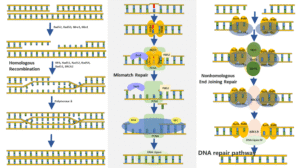Back to: MICROBIOLOGY 200 LEVEL
Welcome to class!
Hello, my superstar learner! It’s great to have you back. You’re doing a fantastic job navigating these topics in microbiology. Today’s lesson is one that shows just how amazing the human body truly is — DNA Repair Pathways. Think of this topic like talking about mechanics who fix broken parts in your car engine — except this time, it’s your DNA that gets the repairs!
DNA Repair Pathways (Mismatch, Excision, Sos)
Have you ever typed a message and noticed autocorrect fixing a spelling error before you even press send? Or maybe you mistakenly tore your jotter, but with a little gum and tape, you fixed it up nicely? That’s how your cells behave when something damages the DNA — they have built-in tools to spot the errors and repair them. These repair systems are what we call DNA repair pathways.

Even though DNA is very stable, it’s not perfect. Mistakes can happen during replication, or damage can occur from things like sunlight or chemicals. Thankfully, your cells are like good housekeepers — they work quickly to fix these problems before they cause bigger issues.
Let’s look at three major types: Mismatch repair, Excision repair, and SOS repair.
Mismatch Repair (MMR)
This repair pathway fixes wrong base pairs that are accidentally added during DNA replication.
For example, if adenine (A) is wrongly paired with cytosine (C) instead of thymine (T), mismatch repair enzymes detect it and correct it.
Think of this as the red biro of your English teacher correcting spelling errors in your essay!
Excision Repair
There are two types:
Base Excision Repair (BER) – repairs small, single base damage.
Nucleotide Excision Repair (NER) – fixes bigger damage like UV-induced thymine dimers.
These enzymes first cut out the damaged part of the DNA, then fill and seal it with the correct base.
It’s like cutting out a torn patch from your school uniform and sewing in a fresh, clean piece of fabric.
SOS Repair
This is an emergency response used when the DNA damage is too severe.
Instead of correcting every single mistake, the cell just tries to quickly copy past the damage, hoping to survive.
It uses special enzymes called translesion polymerases which are more tolerant of damage.
This is like using masking tape to temporarily patch up a car tyre just to get to the nearest vulcaniser. Not perfect, but better than doing nothing!

Let’s say you’re preparing a project file. If you notice a small spelling error, you clean it with a correction pen (MMR). If a whole paragraph gets smudged by water, you tear out the page and rewrite it (Excision Repair). But if time is running out and you still have errors, you quickly staple the messy page and submit it just to meet the deadline (SOS Repair). That’s exactly how your cells respond to DNA damage depending on the situation.
Summary
- DNA repair pathways correct damage to ensure the genetic code stays accurate.
- Mismatch repair fixes incorrect base pairings during replication.
- Excision repair removes and replaces damaged sections of DNA.
- Base Excision Repair handles small damage, while Nucleotide Excision Repair handles larger lesions.
- SOS repair is an emergency pathway that allows the cell to survive severe DNA damage, even if errors are left behind.
Evaluation
- What is the role of DNA repair pathways?
- Describe how mismatch repair works.
- What is the difference between base excision and nucleotide excision repair?
- Why is SOS repair considered an emergency response?
- Give a real-life example that explains excision repair.
You’ve just understood how your body defends itself from genetic damage — how cool is that? Keep going strong, because every lesson takes you closer to your dream of becoming an expert in science and life. Afrilearn is so proud to support you in this journey. Stay motivated, and I’ll see you in the next engaging class!
